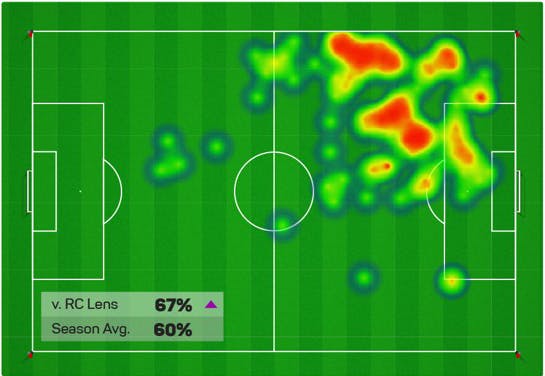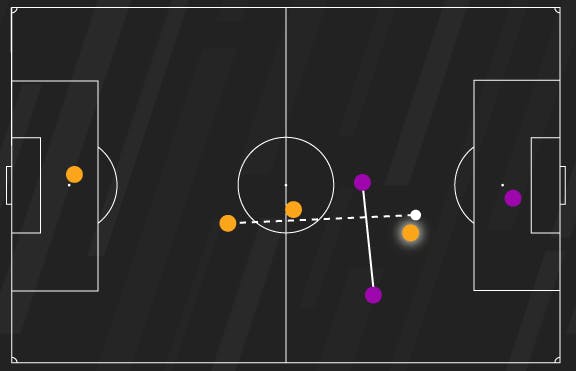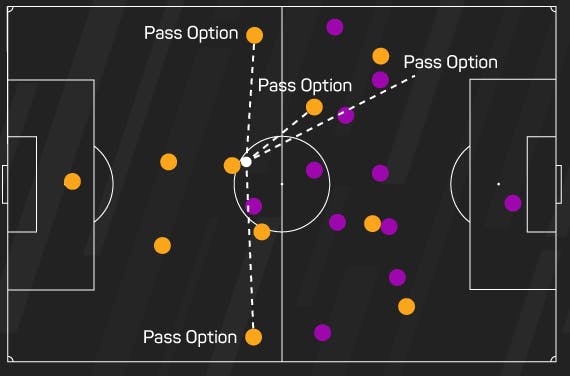Storytelling has become an essential tool for sports broadcasters that are seeking to differentiate their offering. With this in mind, Stats Perform is confident that the launch of its new Opta Vision service ahead of the start of the 2022-23 football season will provide such platforms with the opportunity to elevate their coverage above the competition.
Opta Vision merges Stats Perform’s Opta performance datasets with tracking data, captured via stadium feeds from camera systems installed at match venues and, for the first time, remote tracking collection from video sources, through cutting-edge computer vision technology.
The data feeds utilise Stats Perform’s Qwinn artificial intelligence (AI) to generate data outputs and predictive metrics, providing quantifiable insights such as changes to a team’s shape during a match and pass predictions based on player movements.
“By synchronising event and tracking data and then utilising our AI capabilities to generate enriched insights, we will be empowering performance analysis departments at teams, as well as a broadcaster’s production team, to identify new performance trends,” says Stats Perform’s vice-president of product innovation, Bradford Griffiths.
“We are proud to be at the forefront of innovation in developing engaging and tactically relevant data outputs, helping Stats Perform clients successfully leverage the potential of predictive data.”
Foundations
According to Jens Melvang, Stats Perform’s Senior Project Manager, the foundations for Opta Vision were established by the company’s years of experience in working with professional sports clubs on data-tracking technologies.
 There has also been a rising interest from broadcasters, producers, commentators and pundits in exploring relatable data-driven narratives in response to an increasing appetite from sports fans for engaging insights that will enhance their enjoyment of the spectacle.
There has also been a rising interest from broadcasters, producers, commentators and pundits in exploring relatable data-driven narratives in response to an increasing appetite from sports fans for engaging insights that will enhance their enjoyment of the spectacle.
“We have engaged with broadcast talent for 10-plus years as a company, to help them understand the best ways to tell stories through data,” Melvang says.
“Over the past few months in particular, we have had more conversations with talent – either directly or indirectly through producers – because they are becoming more curious about data-based analytical insights. The point about Opta Vision is that it is coach-friendly, so it quantifies aspects of the game that will be familiar to former players.
“With Opta Vision we will be working even more closely with producers and talent to utilise the tactically focused data to tell those analytical stories.”
Flexibility
Broadcasters are increasingly aware of the need to offer a variety of insights, so they can cater to a as broad an audience as possible. Whilst the likes of UK pay-television broadcaster Sky’s ‘Monday Night Football’ programme, or ‘Match of the Day’, the long-running flagship highlights show from UK public-service broadcaster the BBC, have increasingly embraced deep-dive analysis, such an approach may not engage more sporadic followers of football or the English Premier League.
Therefore, the key is to use flexible tools like Opta Vision to enhance the experience for different types of viewers.
“It’s always about understanding the audience,” Melvang says. “One of the things we have focused on is how to work with broadcasters to provide content that is flexible enough to engage every type of viewer, from those who will debate the tactics that will decide the game with their friends in the pub to those who will tune in sporadically.”
Whatever the data-based insights in the pipeline, the viewer’s perspective always needs to be the priority, Melvang explains.
 “With some broadcasters, there is a concern that overwhelming the viewer with too much data and information about the game on the primary viewing screen could be off-putting,” he adds. “So, for example, perhaps second-screen devices and social media channels may be better avenues for striking data-driven visualisations that inform and entertain.
“With some broadcasters, there is a concern that overwhelming the viewer with too much data and information about the game on the primary viewing screen could be off-putting,” he adds. “So, for example, perhaps second-screen devices and social media channels may be better avenues for striking data-driven visualisations that inform and entertain.
“You have to make sure the audience really engages with the content and understands it, so the process is an evolution. Opta Vision will be really powerful in the second-screen scenario, as well as the first screen, and it will help to extend the storytelling timeframe before and after the event to extend the engagement lifespan.”
Visualisations
Stats Perform’s data editorial team supports the creation of the insights through pre-game ‘commentator packs’ that comprise numerous snippets of information about the players and teams involved, including potential milestones during the contest, as well as AI-driven content.
Furthermore, potential in-game visualisations are established in advance, with the broadcaster then able to pick and choose which are to be used.
“For an average broadcast, there might be between five and eight graphics to push out during the game, but the broadcaster may only end up using a couple per half, so it really depends on the game,” Melvang says.
“We think carefully about the potential to convert an insight into something visually impressive. However, some of these broadcasters have their own analysts working with Stats Perform data to find interesting narratives, so it is about supporting them as well.”
Future direction
 For Stats Perform, Opta Vision is designed to provide broadcasters with the opportunity to empower viewers to engage with the action on their terms.
For Stats Perform, Opta Vision is designed to provide broadcasters with the opportunity to empower viewers to engage with the action on their terms.
Whilst insights provided in advance of a sporting event will help to develop an enduring narrative, the chance to offer fresh perspectives of live action will be particularly enticing, according to Melvang.
“Historically, a lot of content placed on screen during a linear broadcast was prepared in advance,” he says.
“With tools like Opta Vision, though, we believe we will be able to be even more reactive to situations and offer a much broader range of content that offers rich, tactical storytelling insights that are much more tailored to what is happening during a game.”